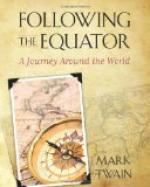A great Indian river, at low water, suggests the familiar anatomical picture of a skinned human body, the intricate mesh of interwoven muscles and tendons to stand for water-channels, and the archipelagoes of fat and flesh inclosed by them to stand for the sandbars. Somewhere on this journey we passed such a river, and on a later journey we saw in the Sutlej the duplicate of that river. Curious rivers they are; low shores a dizzy distance apart, with nothing between but an enormous acreage of sand-flats with sluggish little veins of water dribbling around amongst them; Saharas of sand, smallpox-pitted with footprints punctured in belts as straight as the equator clear from the one shore to the other (barring the channel-interruptions)—a dry-shod ferry, you see. Long railway bridges are required for this sort of rivers, and India has them. You approach Allahabad by a very long one. It was now carrying us across the bed of the Jumna, a bed which did not seem to have been slept in for one while or more. It wasn’t all river-bed—most of it was overflow ground.
Allahabad means “City of God.” I get this from the books. From a printed curiosity—a letter written by one of those brave and confident Hindoo strugglers with the English tongue, called a “babu”—I got a more compressed translation: “Godville.” It is perfectly correct, but that is the most that can be said for it.
We arrived in the forenoon, and short-handed; for Satan got left behind somewhere that morning, and did not overtake us until after nightfall. It seemed very peaceful without him. The world seemed asleep and dreaming.
I did not see the native town, I think. I do not remember why; for an incident connects it with the Great Mutiny, and that is enough to make any place interesting. But I saw the English part of the city. It is a town of wide avenues and noble distances, and is comely and alluring, and full of suggestions of comfort and leisure, and of the serenity which a good conscience buttressed by a sufficient bank account gives. The bungalows (dwellings) stand well back in the seclusion and privacy of large enclosed compounds (private grounds, as we should say) and in the shade and shelter of trees. Even the photographer and the prosperous merchant ply their industries in the elegant reserve of big compounds, and the citizens drive in thereupon their business occasions. And not in cabs—no; in the Indian cities cabs are for the drifting stranger; all the white citizens have private carriages; and each carriage has a flock of white-turbaned black footmen and drivers all over it. The vicinity of a lecture-hall looks like a snowstorm,—and makes the lecturer feel like an opera. India has many names, and they are correctly descriptive. It is the Land of Contradictions, the Land of Subtlety and Superstition, the Land of Wealth and Poverty, the Land of Splendor and Desolation, the Land of Plague and Famine, the Land of the Thug and the Poisoner, and of the Meek and the Patient, the Land of the Suttee, the Land of the Unreinstatable Widow, the Land where All Life is Holy, the Land of Cremation, the Land where the Vulture is a Grave and a Monument, the Land of the Multitudinous Gods; and if signs go for anything, it is the Land of the Private Carriage.




